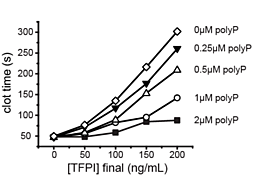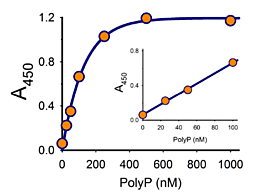Methods for Quantifying Polyphosphate in Biological Samples
TECHNOLOGY NUMBER: 2018-283


OVERVIEW
Permits improved detection of polyphosphate in patient blood samples- Allows for detection and quantification of polyphosphate in waste water
- Anticlotting therapy for patients with DVT, sepsis, trauma, and cancer
BACKGROUND
Polyphosphate (polyP) is a linear polymer of inorganic orthophosphates that is widespread in biology. Interest in the role of polyP as a procoagulant molecule in humans has grown since it has been shown to be important in the processes of deep venous thrombosis, sepsis, trauma, and cancer. Additionally, beyond its biological relevance, polyP may also be detected in sewage and wastewater where it accumulates due to the activities of microorganisms. In this arena, polyP is useful in removing excess phosphate from the wastewater. However, progress in studying polyP has been hampered by a dearth of methods and tools for manipulating and analyzing its properties. There is not an easy method to determine levels of polyP in the blood, limiting scientific understanding of the ways that it may play a part in the illnesses it influences. Similarly, there is currently no easy method for quantification of polyP for quantification from environmental samples. A need exists for a means to better study polyP.
INNOVATION
Researchers have discovered a technology that addresses the need for an assay to evaluate polyP levels both in biologic and environmental samples. The invention involves an assay for quantifying inorganic phosphate in plasma by measuring the concentration-dependent shortening of clot times in plasma that has been spiked with the anticoagulant protein, tissue factor pathway inhibitor (TFPI). This test is highly sensitive to the presence of polyP of the lengths secreted by activated human platelets. Since it is a clotting assay, it can be performed using standard coagulometers that are already in wide use in clinical laboratories. The ability to quantify polyP may lead to more targeted anticoagulation therapies, and a wide variety of modifications could be useful for studies such as western blots and flow cytometry. Further research can also optimize the study of polyP in environmental settings.
PATENT APPLICATION
Number: WO 2018/191582